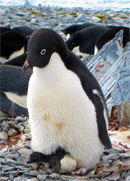Introducing the Torgersen Island Penguin Camera (See it here!)
The Penguin Camera is located on Torgersen Island (64°46’S, 64°04’W), off the coast of Anvers Island and less than a mile from Palmer Station. Torgersen Island is home to a colony of Adélie penguins numbering approximately 2,500.
This camera is seasonal and operates primarily from October to February, the Adélie breeding season. The camera is solar-powered and may sometimes experience brief outages due to inclement weather. School classrooms and other educational demonstrations will often take control of the camera, moving it to gain better views of the colony.
During the camera's operational period, both adult birds and chicks can be seen. An Adélie breeding pair will often take turns caring for chicks while the other takes to the sea to feed on krill. While primarily home to Adélies, other penguins can sometimes be seen on Torgersen Island, including Gentoo and Chinstrap penguins.
For more information, see the Penguin Science
FYI:
Average temperatures are 36° F (2° C) in austral summer and 14° F (-10° C) in austral winter. The station frequently experiences high winds, sometimes reaching 70 knots or more. Average annual precipitation is 13 feet (4 meters) of snow and 30 in (76 cm) of rain. Palmer Station lies outside the Antarctic Circle, so in the middle of austral winter there are five hours of light during each day.
Conversely, the austral summer brings long days of 19 hours of light and 5 of twilight. These changes in light influence seasonal cycles of temperature, weather, sea ice formation, and the organisms that live in this area.
source




















No comments:
Post a Comment